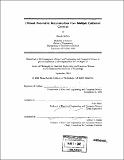| dc.contributor.advisor | Seth Teller. | en_US |
| dc.contributor.author | Jethwa, Manish, 1976- | en_US |
| dc.contributor.other | Massachusetts Institute of Technology. Dept. of Electrical Engineering and Computer Science. | en_US |
| dc.date.accessioned | 2006-03-24T18:25:26Z | |
| dc.date.available | 2006-03-24T18:25:26Z | |
| dc.date.copyright | 2004 | en_US |
| dc.date.issued | 2005 | en_US |
| dc.identifier.uri | http://hdl.handle.net/1721.1/30163 | |
| dc.description | Thesis (Ph. D.)--Massachusetts Institute of Technology, Dept. of Electrical Engineering and Computer Science, February 2005. | en_US |
| dc.description | Includes bibliographical references (p. 137-142). | en_US |
| dc.description.abstract | The automatic reconstruction of large scale 3-D models from real images is of significant value to the field of computer vision in the understanding of images. As a consequence, many techniques have emerged to perform scene reconstruction from calibrated images where the position and orientation of the camera are known. Feature based methods using points and lines have enjoyed much success and have been shown to be robust against noise and changing illumination conditions. The models produced by these techniques however, can often appear crude when untextured due to the sparse set of points from which they are created. Other reconstruction methods, such as volumetric techniques, use image pixel intensities rather than features, reconstructing the scene as small volumetric units called voxels. The direct use of pixel values in the images has restricted current methods to operating on scenes with static illumination conditions. Creating a volumetric representation of the scene may also require millions of interdependent voxels which must be efficiently processed. This has limited most techniques to constrained camera locations and small indoor scenes. The primary goal of this thesis is to perform efficient voxel-based reconstruction of urban environments using a large set of pose-instrumented images. In addition to the 3- D scene reconstruction, the algorithm will also generate estimates of surface reflectance and illumination. Designing an algorithm that operates in a discretized 3-D scene space allows for the recovery of intrinsic scene color and for the integration of visibility constraints, while avoiding the pitfalls of image based feature correspondence. | en_US |
| dc.description.abstract | (cont.) The algorithm demonstrates how in principle it is possible to reduce computational effort over more naive methods. The algorithm is intended to perform the reconstruction of large scale 3-D models from controlled imagery without human intervention. | en_US |
| dc.description.statementofresponsibility | by Manish Jethwa. | en_US |
| dc.format.extent | 142 p. | en_US |
| dc.format.extent | 8204361 bytes | |
| dc.format.extent | 8223335 bytes | |
| dc.format.mimetype | application/pdf | |
| dc.format.mimetype | application/pdf | |
| dc.language.iso | eng | en_US |
| dc.publisher | Massachusetts Institute of Technology | en_US |
| dc.rights | M.I.T. theses are protected by copyright. They may be viewed from this source for any purpose, but reproduction or distribution in any format is prohibited without written permission. See provided URL for inquiries about permission. | en_US |
| dc.rights.uri | http://dspace.mit.edu/handle/1721.1/7582 | |
| dc.subject | Electrical Engineering and Computer Science. | en_US |
| dc.title | Efficient volumetric reconstruction from multiple calibrated cameras | en_US |
| dc.type | Thesis | en_US |
| dc.description.degree | Ph.D. | en_US |
| dc.contributor.department | Massachusetts Institute of Technology. Department of Electrical Engineering and Computer Science | |
| dc.identifier.oclc | 60663131 | en_US |
